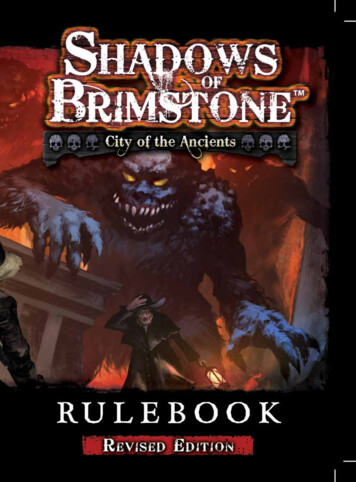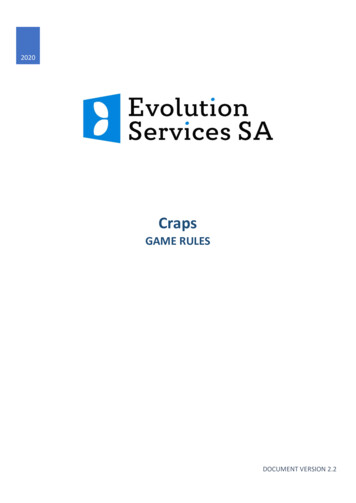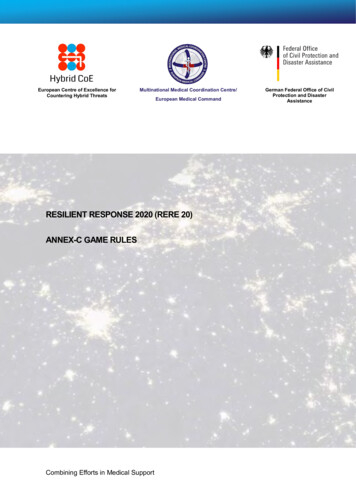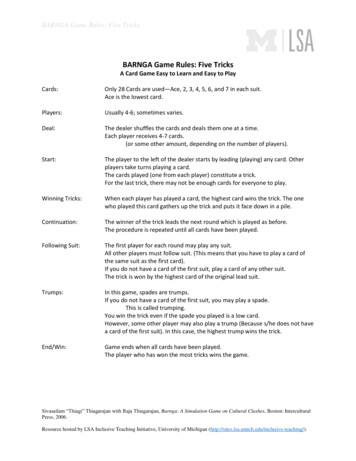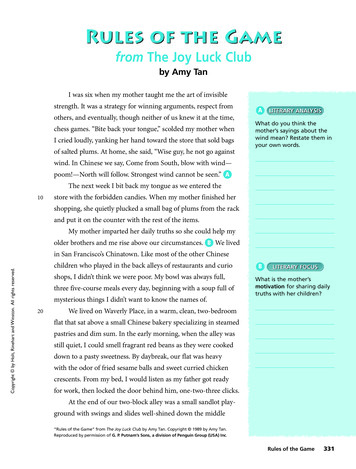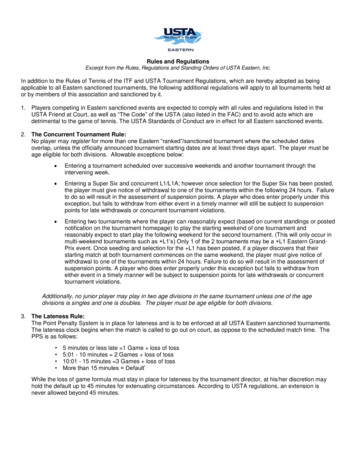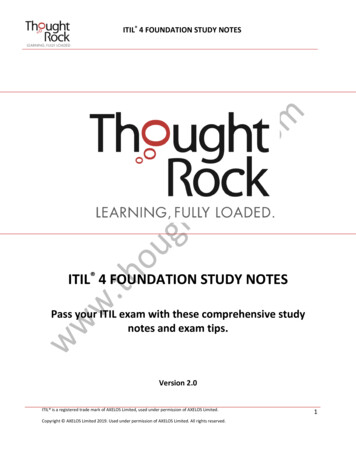
Transcription
“The Rules of the Game”By: Amy TanBy Amy TanPublish Date: 1985
Amy R. Tan Born February 19, 1952 in Oakland, CA Grew up in California and Switzerland Graduated from University of California, Berkeley Writes about Chinese American Women and theimmigrant experience
Other works by the author: The Joy Luck Club The Kitchen God’s Wife The Hundred Secret Senses The Bonesetter’s DaughterChildren’s Books: The Moon Lady The Chinese Siamese Cat
Setting Chinatown in San Francisco, California, Urban Mid to late 1950’s Insular Immigrant Community Lower to Middle Class Changes main character’s perspective on the world More Free Ranging; Affected by Parents’ Beliefs
Brief Summary:In the short story “Rules of the Game” by Amy Tan, Waverly Jong, the main character, is a chessprodigy. Waverly is a nine year old living with her middle-lower class family in Oakland, California,near Chinatown during the mid 1900s. Vincent, Waverly’s brother, receives a chess set for Christmasand Waverly begs her brothers to let her play with them. Soon enough, Waverly starts to join in on thechess games, by giving up her lifesavers in compensation for the missing chess pieces. One day,Waverly spots a gathering of old men playing chess. She immediately hopes they will let her join in.Waverly starts to compete against a man named Lau Po, who teaches Waverly a plethora of chesssecrets and skills to help her win tournament. Waverly soon enters a tournament, and ends up makingit all the way to Nationals, after winning again and again. At this point, Waverly’s mom is involved inher success, bragging whenever she can, to the extent that Waverly is irritated to the point that sheyells at her mom for acting as an embarrassment, and runs far away from her mom. Coming homehours later, Waverly heads into her room. She sees her mom’s beady black eyes across the chessboardhanging from her wall, as her opponent. “Strongest wind cannot be seen,” her opponent says, leavingWaverly to ponder her next move.
Main points of summary: Oakland’s Chinatown, California, USA during the 1950smiddle-lower class salary familyreceives chess set for ChristmasWaverly Jong becomes a prodigymom brags about Waverly’s successesWaverly gets annoyed and runs offlearns the power and importance of “invisible strength”
The Point-of-View First Person Allows the Reader to empathize more with the maincharacter and her struggles Gives the Reader insight into what the Waverly isthinking and feeling Hides from Reader what Waverly’s mother is thinking
Symbol: “The art of invisible strength”Invisible strength: Strength that cannot be seen, but can help topower through obstaclesThe “art of invisible strength” is taught to Waverly by her mother asa way to win respect from others and dominate in games. These rulesare forever changing and very difficult to learn. Self-control is an“invisible strength” that can help Waverly learn and grow. Byneglecting Waverly after she runs away, Mrs. Jong is equippingWaverly with life skills she needs later on. From the start to end of thestory, the enforcing of this “invisible strength” was demonstrated manytimes.
Symbol: “The art of invisible strength Waverly describes herself as the fish the family ate for dinneruses her self-control and thinking as “strong wind”demonstrates self-control, a form of invisible strengthmom doesn’t concern Waverly after she runs awaylearning how to control yourself win battles deal with life Waverly sees two black slits across the chessboard “strongest wind cannot be seen”
Theme For every benefit, there is a cost. Due to her success in chess, Waverly is givenfewer chores by her parents, BUT she mustput up with her mother’s bragging Like the metaphor at the end of the story, iflife is like chess, it is sometimes required tosacrifice lesser pieces i.e. a pawn in order towin something greater i.e. a queen
Rating: 2.3 StarsPros: inciting incident was creativesymbolism in the story was clearly thought outlives of Chinese immigrants were accurate (for the time period)scene and characters came to life, and were realisticallowed reader to think about Waverly’s lifeadjective usage let reader easily picture the situation the characterswere in a lot of figurative language was used, e.g. “my white pieces screamed asthey scurried and fell off the board”
Rating: 2.3 StarsCons: include more of the mom in the story wasn’t enough for reader to fully understand backgroundinformation of Chinese immigrants wishy-washy main character not an interesting topic unclear resolution
Types of Characters: major character: where the attention is focused, takes lots ofaction in the story minor character: not the main focus of the story, but takesplace in the story round character: fully developed, with multiple traits (faultsand virtues) flat character: one sided, stereotypical dynamic character: character that changes or grows duringthe course of the work static character: a character who doesn’t change
Character: Waverly Jong round character, major character, dynamiccharacter stubborn, unappreciative, talented girl fault: hasn’t yet recognized the sacrifices her mommade and let’s her child stubbornness get to her virtue: self-taught chess prodigy at a young age,strives for success main character/protagonist
Character: Lindo Jong (mother) round character, minor character, dynamic character faults: isn’t fully immersed in American parenting strict, harsh, strong virtues: wants the best for her kids makes sacrifices for Waverly opposed to main character/antagonist
Characters: Vincent, Winston, and Mr. Jong minor characters, static characters, flatcharacters in the background not really vital to the plot
Types of Characterization: Direct Characterization: traits are stated by thewriter Indirect Characterization: writer depends on thereader to draw conclusions about the character’s traits,sometimes tells what other characters think and sayabout the character Character Traits Characterization: qualities,attitudes, and values a character displays
Characterization: Waverly Jong indirect characterization Waverly’s thoughts hard working self learns chess rebellious runs from mother curious possesses desire to learn ungrateful inferred from Mother’s words
Characterization: Lindo Jong (mother) indirect characterization actions towards Waverly reveals some traits sacrificing sacrifices for Waverly to succeed nosy continuously watches Waverly practice harsh calls daughter “stupid”
Author TechniquesForeshadowing: Amy Tan uses Foreshadowing closer to the end of the storywhen Waverly is getting nationally recognized and her mother is giving her timeoff her chores. This was getting a little too good to be true and some kind ofmeltdown was definitely foreseeable.Imagery: Tan uses imagery really well when she is describing the Chinatownneighborhood that Waverly grows up in. When she talks about the alley thatthey have numerous adventures in and the forbidden and scary restaurant inthe corner, it’s easily visible in the minds eye.Metaphor: A metaphor is used when comparing a chess game to life and thedecisions and sacrifices made to ultimately achieving success, and they arereally similar. It is shown in the story.
Plot DiagramRising Action Inciting Incident: Waverly’s brotherVincent receives a chess board at aChristmas Party at the First ChineseBaptist Church Exposition On Waverly Place above aChinese Bakery in a smallapartmentLower Middle Class FamilyChina Town, San Francisco,CaliforniaMid to late 1900’s Waverly’s brothers allow her toplay chess after she bribes themwith lifesaversWaverly reads instructionalchess books and learns to playand wins all chess gamesWaverly begins to play chesswith other men in theneighborhood and her playingability improvesWaverly begins going to chesstournaments and wins gameafter gameWaverly stops playing chess withlocals
Falling Action Waverly returns home afterrunning away from her motherShe is ignored by the family perher mother’s commandClimax: Waverly confronts hermother in the market, saying that shedislikes how her mother is usingWaverly to boast and give herself airsResolution Waverly goes to her room andthinks about her mother’spower; Waverly begins to planher next move
Video analysis on “Rules of the Game”
Citations Page"Amy Tan." Britannica School. Encyclopædia Britannica, Inc., 2014. Web. 3 Oct. 2014. http://school.eb.com/levels/high/article/99916 jpg
accessed 10/1/14http://www.desktopaper.com/wp- accessed 10/1/14content/uploads/cool-chess-board- wallpaper.jpgchess-board-wallpaper.jpg\accessed 916
The Joy Luck Club The Kitchen God’s Wife The Hundred Secret Senses The Bonesetter’s Daughter Children’s Books: The Moon Lady The Chinese Siamese Cat. . More Free Ranging; Affected by Parents’ Beliefs. Brief Summary: In the short story “Rules of the Game”
